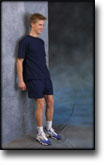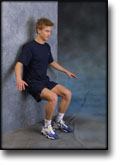|
Treatment of chronic exertional anterior compartment syndrome with massage: a pilot study.
Blackman PG, Simmons LR, Crossley KM. Clin J Sport Med 1998 Jan;8(1):14-7.
OBJECTIVE.
To determine the effect of massage on anterior chronic exertional compartment syndrome (CECS) with respect to symptoms, intracompartmental pressures, and work output of the anterior compartment in dorsiflexion.
DESIGN.
One group-repeated measures design.
SETTING.
A private sports medicine clinic in Melbourne, Australia.
PARTICIPANTS.
Seven athletes (six men and one woman), aged between 21 and 29 years, were selected on the basis of clinical suspicion for anterior CECS. Historical questionnaire and examination were followed by intracompartmental pressure testing of the anterior compartment. Study exclusion criteria were history of a bleeding diathesis and previous treatment consisting of compartment fasciotomy or massage. All athletes completed the study.
INTERVENTIONS.
A 5-week course of massage consisting of two sessions in the first week and one session per week thereafter, for a total of six treatments. Between each session, a twice-daily standard stretching program involving both anterior and posterior compartments was performed.
MAIN OUTCOME MEASURES.
Postexercise anterior compartment pressures (mm Hg) before and after treatment, work output (J) in dorsiflexion to pain onset before and after treatment, self-reported symptoms before and after treatment.
RESULTS.
There was no significant difference in the 3-minute postexercise compartment pressures after the treatment. There was a significant (p = 0.016) increase, however, in work performed in dorsiflexion to pain onset following the massage course.
CONCLUSIONS.
Intermittent massage combined with specific stretching should be considered in the treatment of anterior CECS.
|































